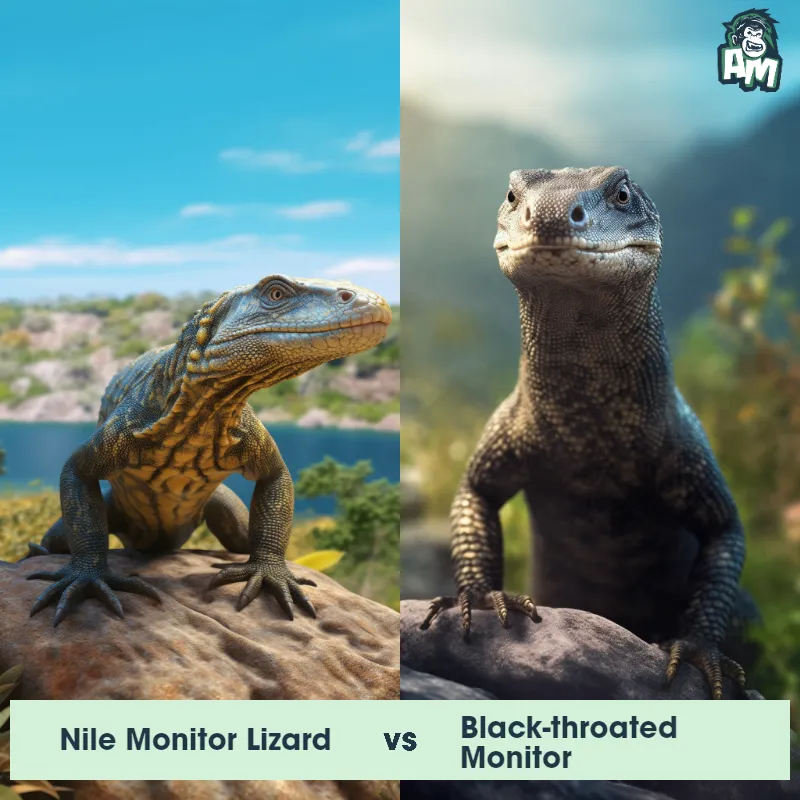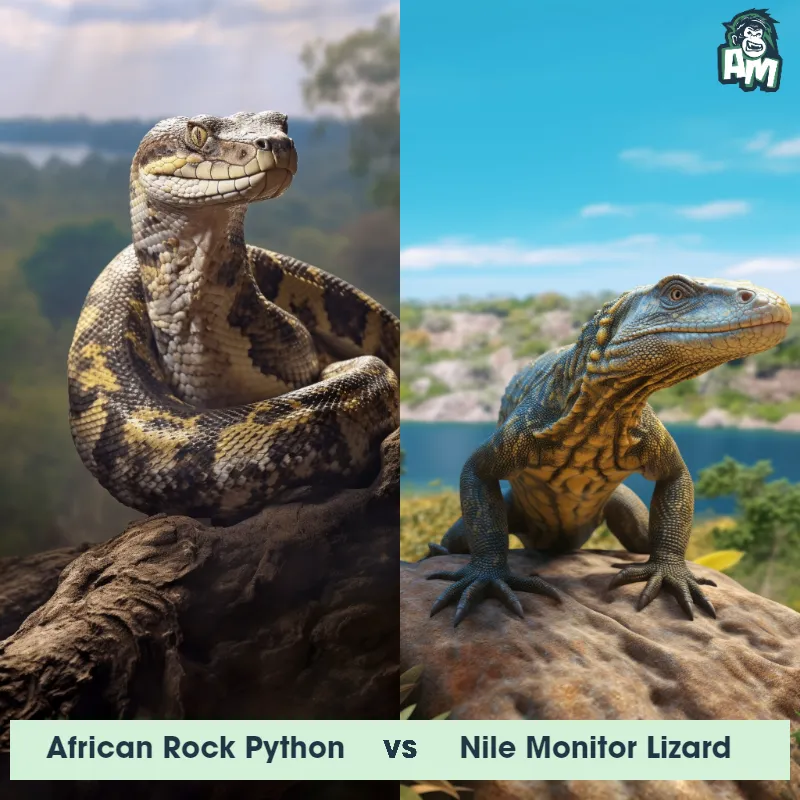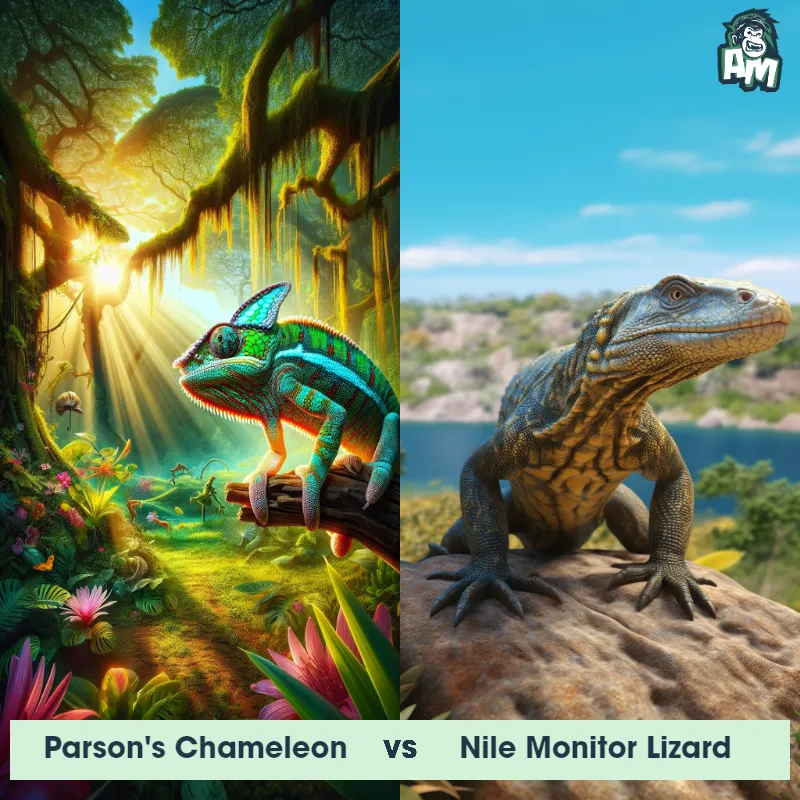The Nile Monitor Lizard
The Nile Monitor Lizard, scientifically known as Varanus niloticus, is a large and powerful reptile that can grow up to 7 feet long. It has a slender body covered in rough scales, with a long muscular tail and sharp claws. Its coloration can vary, but it typically has a dark brown or black body with yellowish markings, providing effective camouflage in its natural habitat of wetlands and rivers. Nile Monitor Lizards are skilled swimmers and climbers, with strong jaws filled with sharp teeth that allow them to feed on a variety of prey including fish, birds, small mammals, and even carrion.

| Nile Monitor Lizard | |
|---|---|
| Size | Up to 7 feet (2.1 meters) long |
| Weight | Up to 200 pounds (91 kilograms) |
| Speed | Speed: 11 mph (17.7 km/hr) |
| Key Strength | Powerful legs and tail for defense |
| Biggest Weakness | Vulnerable to attacks on the underside of their body |
| Scientific Name | Varanus niloticus |
| Family | Varanidae |
| Habitat | Freshwater and terrestrial environments |
| Geography | Sub-Saharan Africa |
| Diet | Opportunistic predator, eats fish, birds, small mammals, and other reptiles |
| Lifespan | 12 years - 20 years |

The Nile Monitor Lizard
The Nile Monitor Lizard, scientifically known as Varanus niloticus, is a large and powerful reptile that can grow up to 7 feet long. It has a slender body covered in rough scales, with a long muscular tail and sharp claws. Its coloration can vary, but it typically has a dark brown or black body with yellowish markings, providing effective camouflage in its natural habitat of wetlands and rivers. Nile Monitor Lizards are skilled swimmers and climbers, with strong jaws filled with sharp teeth that allow them to feed on a variety of prey including fish, birds, small mammals, and even carrion.
Fun Fact: Nile Monitor Lizards possess a forked tongue, which they use to navigate their surroundings and find prey. This tongue collects chemical signals from the environment, allowing the lizard to detect scent trails and locate food with remarkable accuracy.
| Nile Monitor Lizard | |
|---|---|
| Size | Up to 7 feet (2.1 meters) long |
| Weight | Up to 200 pounds (91 kilograms) |
| Speed | Speed: 11 mph (17.7 km/hr) |
| Key Strength | Powerful legs and tail for defense |
| Biggest Weakness | Vulnerable to attacks on the underside of their body |
| Scientific Name | Varanus niloticus |
| Family | Varanidae |
| Habitat | Freshwater and terrestrial environments |
| Geography | Sub-Saharan Africa |
| Diet | Opportunistic predator, eats fish, birds, small mammals, and other reptiles |
| Lifespan | 12 years - 20 years |
Nile Monitor Lizard Matchups
We use AI to simulate matchups between the Nile Monitor Lizard and other animals. Our simulation considers size, strength, and natural predatory behaviors to determine the most likely outcome.
Nile Monitor Lizard: Diet, Predators, Aggression, and Defensive Behaviors
What do Nile Monitor Lizards eat?
Nile Monitor Lizards are opportunistic feeders and have a diverse diet that includes insects, small mammals, birds, fish, frogs, eggs, and even carrion. They are also known to eat other reptiles, including smaller lizards and snakes. Their diet can vary based on availability and location.
Do Nile Monitor Lizards have any predators?
As adults, Nile Monitor Lizards have very few natural predators due to their large size and powerful jaws. However, eggs and young monitor lizards are vulnerable to predation by birds of prey, large snakes, mammals, and other carnivorous reptiles. In some cases, larger predators like crocodiles and large birds may attempt to prey on adult Nile Monitor Lizards.
Are Nile Monitor Lizards aggressive?
Nile Monitor Lizards have a reputation for being aggressive and territorial. They can exhibit defensive behaviors when threatened, including hissing, tail whipping, and biting. While they may not typically attack humans unprovoked, Nile Monitor Lizards can become aggressive if they feel threatened or cornered.
Do Nile Monitor Lizards fight each other?
Nile Monitor Lizards are known to be territorial animals and will defend their territory from other individuals, especially during the breeding season. When conflicts arise between two Nile Monitor Lizards over territory or mating rights, they may engage in physical combat, using their powerful jaws and claws to intimidate or injure their opponent.
How do Nile Monitor Lizards defend themselves?
When threatened or attacked, Nile Monitor Lizards have several defense mechanisms at their disposal. They can puff themselves up to appear larger, hiss loudly, whip their tail, and use their sharp claws and teeth to defend themselves. They are also capable swimmers and may flee into water to escape predators.
What is the biggest weakness of Nile Monitor Lizards in a fight?
One of the biggest weaknesses of Nile Monitor Lizards in a fight is their relatively thin skin, which can be easily injured or torn by sharp objects, predator claws, or teeth. Despite their tough scales and powerful jaws, their skin is vulnerable to punctures, cuts, and infections, making them more susceptible to injuries during confrontations with predators or other animals.
Fun Fact: Unlike many other lizards, Nile Monitor Lizards are known for their high intelligence and adaptability. They have displayed problem-solving abilities and have been observed using tools in the wild, such as using sticks to extract eggs from nests or to lure birds closer for hunting.
Fun Fact: Nile Monitor Lizards are also known for their reproductive behavior. Females lay their eggs in holes or burrows and cover them with soil, where they incubate and develop for around 10 to 12 weeks. However, interestingly, the sex of the hatchlings is determined by the temperature during incubation, with higher temperatures resulting in males and lower temperatures producing females.














